
The Solar-Terrestrial Centre of Excellence (STCE) is a collaborative network of the Belgian Institute for Space Aeronomy, the Royal Observatory of Belgium and the Royal Meteorological Institute of Belgium.
 |
Published by the STCE - this issue : 7 Dec 2012. The Solar-Terrestrial Centre of Excellence (STCE) is a collaborative network of the Belgian Institute for Space Aeronomy, the Royal Observatory of Belgium and the Royal Meteorological Institute of Belgium. |
| Archive of the newsletters | Subscribe to this newsletter by mail |
Coronal holes are regions in the hot solar atmosphere ("corona") where the plasma density of that temperature is very low compared to its surroundings, and thus they look like dark shapes in the corona. They are also known to be the source of the high-speed solar wind, and as such can create geomagnetic disturbances when aimed at the Earth. As the larger coronal holes may hold their shape through several solar rotations, they are interesting for long term space weather predictions.
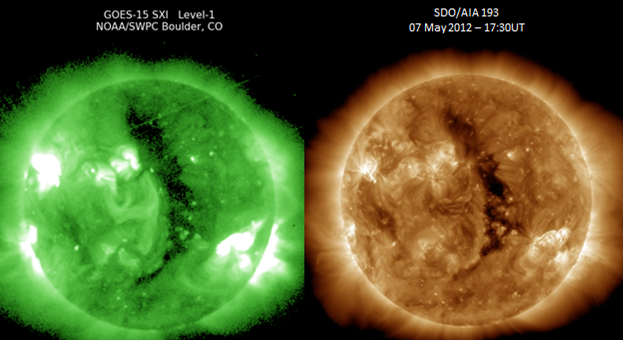
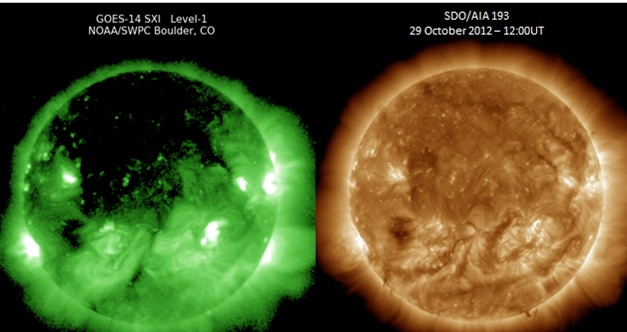
As it turns out, there was no coronal hole at all. An STCE scientist explains: "Coronal holes are best seen in the relatively "cool" wavelengths of the spectrum such as e.g. 19.3 nm (EUV: SDO/AIA 193), corresponding to a temperature of about 1.2 million degrees. If an area looks dark in such images, it means there is not enough material present at that temperature to be visible. That is exactly what happens in coronal holes: The fast solar wind drains the area very quickly of the coronal plasma that otherwise would have been there. As a result, we see a dark area. The normal, quiet corona as well as active regions will not be seen as dark patches in such images.
In SXR-images, the situation is quite different. Such images mainly show plasma at very high temperatures (several millions of degrees). This basically means that in such images, only the active regions (hot) will be visible. Consequently, a black area in SXR-images can mean a coronal hole or the quiet Sun. What we are seeing in this case, and taking into account the EUV-images, is a part of the Sun on which there are significantly less active regions than on the rest of the solar surface."
Actually, the dark area visible in the GOES SXI-images late October and early November corresponds to the inactive "face" of the Sun that was discussed in a previous STCE Newsletter (see http://stce.be/news/169/welcome.html ). Last week, this area made another solar transit, though this time it did not show up as pronounced in the SXI-images as it did a solar rotation ago.

If you were one of the 329 participants, you are invited to fill in the ESWW9 Questionnaire.
If you have a great idea for a plenary session for the tenth ESWW, you are welcome to fill in the ESWW10 Survey.
Both, the questionnaire and the survey can be found in the left menu of http://www.stce.be/esww9
Thanks for your input!
The programme committee
Dear colleagues and interested people,
The Solar-Terrestrial Centre of Excellence holds its 2013 annual meeting on Friday June 7, 2013.
Space Pole members are invited to solicit for a workshop. This workshop can be of course in close collaboration with outside institutes, universities and agencies. The workshops take place well before end May 2013.
The report of the workshop will be presented on June 7 to the whole community. The new thing is that the wrap up is not given by default the session convenor. More information will follow.
Mark your calendar!
The STCE
Dear,
The AFFECTS team cordially invites you to attend the international AFFECTS User Workshop on February 28, 2013. The workshop will cover a full day, and is hosted by the Royal Observatory of Belgium.
AFFECTS (Advanced Forecast For Ensuring Communications Through Space, http://www.affects-fp7.eu) is a space weather research project under the 7th Framework Programme of the European Union, led by the University of Goettingen. Since the start of the AFFECTS project in March 2011, several space weather products, tools and services have been developed by the AFFECTS team. The AFFECTS User Workshop is the venue where we reach out to all interested players and users in space weather in order to demonstrate our products, tools and services.
A brief summary of the AFFECTS products, tools and services that will be presented during the workshop:
- Near real time dimming and EIT wave detection
- 3D CME analysis tool
- Coronal analysis tool
- CME and solar wind arrival and impact forecast tool
- Flare, CME, geomagnetic, auroral, ionospheric forecasts and alerts
- Forecast of perturbed TEC
- Solar activity and space weather timelines viewer
There is no registration fee, but we do ask to register in order to facilitate our planning. To subscribe, please send an e-mail to Doerte.Dannemann at zvw.uni-goettingen.de.
You can find more info about the workshop on http://www.affects-fp7.eu/news-events/user-ws/.
Best regards,
Cis Verbeeck on behalf of the AFFECTS team
Nine sunspot groups were reported by Catania during the week (with NOAA Active Region number given in brackets): 27 (1618), 31 (1620), 32 (1622), 33 (no NOAA number), 34 (1621), 35 (1624), 36 (no NOAA number), 37 (1623), and 38 (1625). Catania sunspot groups 27 (NOAA AR 1618), 31 (NOAA AR 1620), 37 (NOAA AR 1623), and 38 (NOAA AR 1625) produced numerous C-class flares, mostly on November 26-30. Three M-class flares were detected during the week: M1.6 flare in Catania sunspot group 27 (NOAA AR 1618) on November 27, as well as M1.0 and M2.2 flares in Catania sunspot group 31 (NOAA AR 1620) on November 27 and 28 respectively. No Earth-directed CMEs were associated with any of the flares.
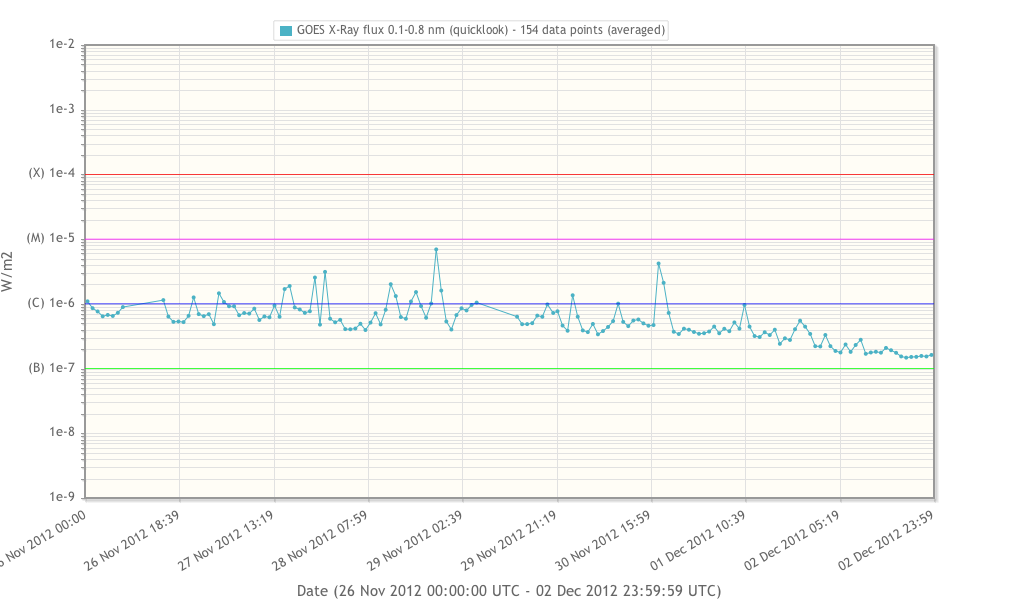
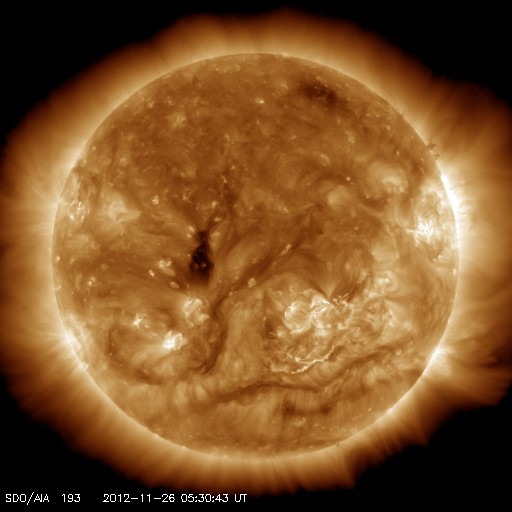
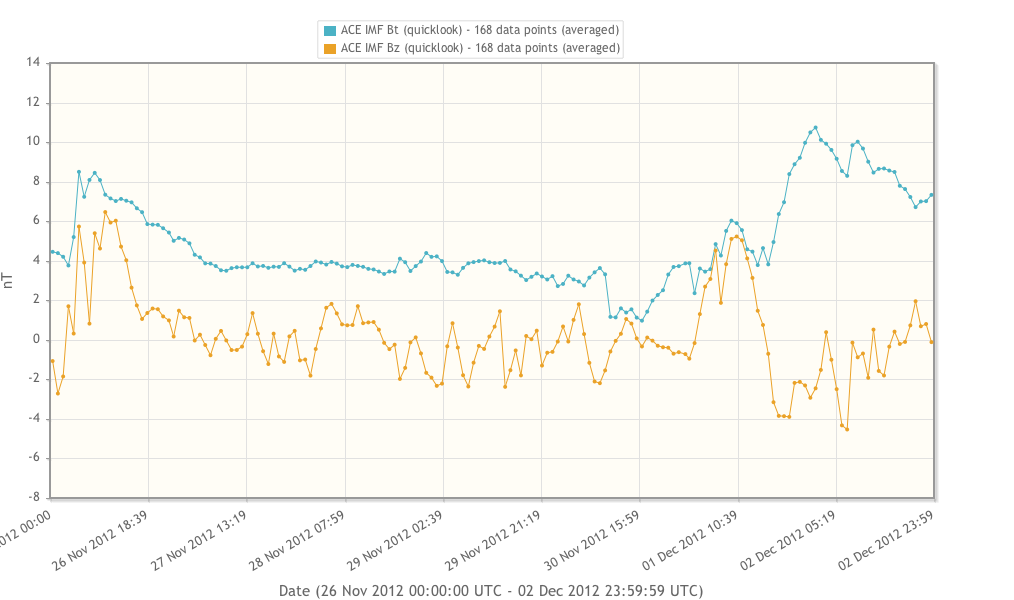
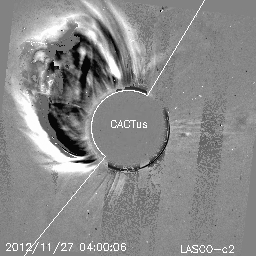
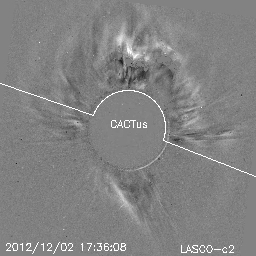
An interplanetary shock wave was detected on November 26 by ACE and SOHO/CELIAS, at 04:32 UT.
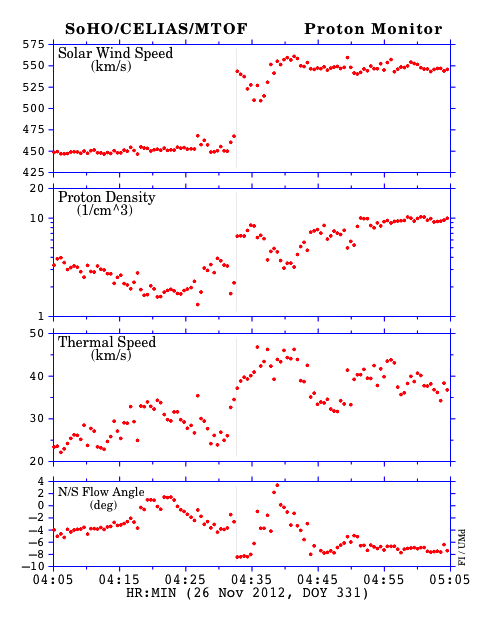
| DAY | BEGIN | MAX | END | LOC | XRAY | OP | 10CM | TYPE | Cat | NOAA | NOTE |
| 27 | 1552 | 1557 | 1603 | N05W73 | M1.6 | SF | 0 | 27 | 1618 | ||
| 27 | 2105 | 2126 | 2130 | S14W41 | M1.0 | SF | 0 | III/1 | 31 | 1620 | |
| 28 | 2120 | 2136 | 2148 | S14W57 | M2.2 | 1F | 0 | 31 | 1620 |
| LOC: approximate heliographic location | TYPE: radio burst type |
| XRAY: X-ray flare class | Cat: Catania sunspot group number |
| OP: optical flare class | NOAA: NOAA active region number |
| 10CM: peak 10 cm radio flux |
Knowledge of the background solar wind is an important input for CME propagation studies. Since in-situ measurements of the background solar wind are only available at 1 AU, we have to rely on heliospheric models to derive the distribution of solar wind parameters in IP space and hence, to do space weather forecasting. We test the performance of the solar wind models ENLIL/MAS, ENLIL/WSA (CCMC) and MAS (Predictive Science) by comparing model results with in-situ measurements from ACE and Wind. For the study we chose the years 2005 and 2007 as a time period with low solar activity. We found that the general structure of the background solar wind is well reproduced by the models. The best model results were obtained for the parameter solar wind speed. However, the predicted arrival times of high speed solar wind streams have typical uncertainties of the order of 1 – 1.5 days.
http://www.spaceweather.eu/en/repository/show?id=339
European Space Weather Landscape: Current Perspectives and Requirements for the Future
http://www.spaceweather.eu/en/repository/show?id=340
European Space Weather Landscape: Current Perspectives and Requirements for the Future
http://www.spaceweather.eu/en/repository/show?id=341
European Space Weather Landscape: Current Perspectives and Requirements for the Future
http://www.spaceweather.eu/en/repository/show?id=342
European Space Weather Landscape: Current Perspectives and Requirements for the Future
http://www.spaceweather.eu/en/repository/show?id=343
European Space Weather Landscape: Current Perspectives and Requirements for the Future
http://www.spaceweather.eu/en/repository/show?id=344
European Space Weather Landscape: Current Perspectives and Requirements for the Future
http://www.spaceweather.eu/en/repository/show?id=345
European Space Weather Landscape: Current Perspectives and Requirements for the Future
http://www.spaceweather.eu/en/repository/show?id=346
European Space Weather Landscape: Current Perspectives and Requirements for the Future
http://www.spaceweather.eu/en/repository/show?id=347
European Space Weather Landscape: Current Perspectives and Requirements for the Future
http://www.spaceweather.eu/en/repository/show?id=348
Innovations and Key Challenges in Space Weather Science
http://www.spaceweather.eu/en/repository/show?id=349
Innovations and Key Challenges in Space Weather Science
http://www.spaceweather.eu/en/repository/show?id=350
Innovations and Key Challenges in Space Weather Science
http://www.spaceweather.eu/en/repository/show?id=351
Innovations and Key Challenges in Space Weather Science
http://www.spaceweather.eu/en/repository/show?id=352
Innovations and Key Challenges in Space Weather Science
http://www.spaceweather.eu/en/repository/show?id=353
Innovations and Key Challenges in Space Weather Science
http://www.spaceweather.eu/en/repository/show?id=354
Innovations and Key Challenges in Space Weather Science
http://www.spaceweather.eu/en/repository/show?id=355
Innovations and Key Challenges in Space Weather Science
http://www.spaceweather.eu/en/repository/show?id=356
Innovations and Key Challenges in Space Weather Science
http://www.spaceweather.eu/en/repository/show?id=357
Solar Variability Effects on Climate
http://www.spaceweather.eu/en/repository/show?id=358
Solar Variability Effects on Climate
http://www.spaceweather.eu/en/repository/show?id=359
Solar Variability Effects on Climate
http://www.spaceweather.eu/en/repository/show?id=360
Solar Variability Effects on Climate
http://www.spaceweather.eu/en/repository/show?id=361
Solar Variability Effects on Climate
http://www.spaceweather.eu/en/repository/show?id=362
Solar Variability Effects on Climate
http://www.spaceweather.eu/en/repository/show?id=363
Solar Variability Effects on Climate
http://www.spaceweather.eu/en/repository/show?id=364
Coupled Space Weather Modelling
http://www.spaceweather.eu/en/repository/show?id=365
Coupled Space Weather Modelling
http://www.spaceweather.eu/en/repository/show?id=366
Coupled Space Weather Modelling
http://www.spaceweather.eu/en/repository/show?id=367
Coupled Space Weather Modelling
http://www.spaceweather.eu/en/repository/show?id=368
Coupled Space Weather Modelling
http://www.spaceweather.eu/en/repository/show?id=369
Coupled Space Weather Modelling
http://www.spaceweather.eu/en/repository/show?id=370
Coupled Space Weather Modelling
http://www.spaceweather.eu/en/repository/show?id=371
Coupled Space Weather Modelling
http://www.spaceweather.eu/en/repository/show?id=372
Coupled Space Weather Modelling
http://www.spaceweather.eu/en/repository/show?id=373
Spacecraft Operations and Space Weather
http://www.spaceweather.eu/en/repository/show?id=374
Spacecraft Operations and Space Weather
http://www.spaceweather.eu/en/repository/show?id=375
Spacecraft Operations and Space Weather
http://www.spaceweather.eu/en/repository/show?id=376
Spacecraft Operations and Space Weather
http://www.spaceweather.eu/en/repository/show?id=377
Spacecraft Operations and Space Weather
http://www.spaceweather.eu/en/repository/show?id=378
Spacecraft Operations and Space Weather
http://www.spaceweather.eu/en/repository/show?id=379
Space Weather in the Solar System
http://www.spaceweather.eu/en/repository/show?id=381
Space Weather in the Solar System
http://www.spaceweather.eu/en/repository/show?id=382
Space Weather in the Solar System
http://www.spaceweather.eu/en/repository/show?id=383
Space Weather in the Solar System
http://www.spaceweather.eu/en/repository/show?id=384
Space Weather in the Solar System
http://www.spaceweather.eu/en/repository/show?id=385
Space Weather in the Solar System
http://www.spaceweather.eu/en/repository/show?id=386
Space Weather in the Solar System
http://www.spaceweather.eu/en/repository/show?id=387
COST ES0803 Final Results
http://www.spaceweather.eu/en/repository/show?id=388
COST ES0803 Final Results
http://www.spaceweather.eu/en/repository/show?id=389
COST ES0803 Final Results
http://www.spaceweather.eu/en/repository/show?id=390
COST ES0803 Final Results
http://www.spaceweather.eu/en/repository/show?id=391
COST ES0803 Final Results
http://www.spaceweather.eu/en/repository/show?id=392
COST ES0803 Final Results
http://www.spaceweather.eu/en/repository/show?id=393
COST ES0803 Final Results
http://www.spaceweather.eu/en/repository/show?id=394
COST ES0803 Final Results
http://www.spaceweather.eu/en/repository/show?id=395
COST ES0803 Final Results
http://www.spaceweather.eu/en/repository/show?id=396
Spacecraft Operations and Space Weather
http://www.spaceweather.eu/en/repository/show?id=397
ESWW9 Splinter wrap up
http://www.spaceweather.eu/en/repository/show?id=398
Presentation given at the conference 'Solar and Heliospheric influences on the geospace', Bucharest, Romania in the session 'Education, dissemination, outreach'
http://www.spaceweather.eu/en/repository/show?id=399
A presentation given for the members of the public observatory 'Armand Pien', Gent: 60 participants.
http://www.spaceweather.eu/en/repository/show?id=400
On October 27, this Dutch presentation was given about Solar Cycle 24 for a group of amateur astronomers, namely the Workgroup Sun of the VVS and the NVWS, 20 people.
http://www.spaceweather.eu/en/repository/show?id=401
Start : 2013-01-14 - End : 2013-01-17
The Atacama Large Millimeter/submillimeter Array (ALMA), an
international partnership of Europe, North America and East Asia in
cooperation with the Republic of Chile, is the largest astronomical
project in existence.
The workshop aims to bring together the ALMA-minded solar
community to discuss solar observational issues with ALMA, solar
science and planned observations with ALMA, and the planning of
solar ALMA observations.
Th workshop is hosted by Astronomy & Astrophysics Group,
and will take place in School of Physics and Astronomy, University
of Glasgow, Room 323, Kelvin Building.
Website:
http://www.astro.gla.ac.uk/~eduard/solarALMA/
Start : 2013-02-04 - End : 2013-02-08
Helioseismology provides tools for imaging structures and mass
flows below the solar surface, and is becoming an essential
technique for understanding the dynamics of solar activities and
developing physics-based forecasts of the solar cycle, emerging
active regions and energy release events. A better understanding is
needed to unravel the effects of the complex interactions of solar
oscillations with the turbulent magnetized plasma
on global and local helioseismology
diagnostics. These effects are particularly challenging in regions
of strong magnetic fields. Numerical simulations of solar MHD waves
and turbulent dynamics give important insights into the complicated
wave and turbulence physics, and provide synthetic data for
verification and validation of helioseismology methods and
results.
The goals of this workshop are to discuss and stimulate further
development of helioseismology methods, solar interior models, and
realistic numerical simulations. These goals are particularly
important for analysis of the continuous data flow from the Solar
Dynamics Observatory, development and verification of
helioseismology methods, and for theoretical interpretation of
observations and inversion results.
Website:
http://sun.stanford.edu/LWS2013/
Start : 2013-02-28 - End : 2013-02-28
On February 28th, 2013 the AFFECTS team organises an
international user workshop at the Royal Observatory of Belgium in
Brussels.
At the workshop there will be a demonstration of all AFFECTS
space weather
products:
* Near real time dimming and EIT
wave detection
* 3D CME
analysis tool
* Coronal analysis tool
* CME
& solar wind
arrival and impact forecast
tool
* Flare, CME
, geomagnetic, auroral, ionospheric
forecasts & alerts
* Forecast of perturbed TEC
* Solar activity and space weather
timelines viewer
To register, please send an e-mail incl. your full name,
institution, e-mail and (institutional) address to
.
Dörte Dannemann
Website:
http://www.affects-fp7.eu/news-events/user-ws/
Start : 2013-04-07 - End : 2013-04-12
The EGU General Assembly 2013 will bring together geoscientists
from all over the world into one meeting covering all disciplines
of the Earth, Planetary and Space Sciences. Especially for young
scientists, it is the aim of the EGU to provide a forum where they
can present their work and discuss their ideas with experts in all
fields of geosciences. The EGU is looking forward to cordially
welcoming you in Vienna.
Website:
http://www.egu2013.eu/home.html
Start : 2013-04-08 - End : 2013-04-12
The most recent solar minimum, solar cycle 23-24 minimum, was
unusually long (266 spotless days in 2008, the most since 1913),
and the magnetic field at the solar poles was approximately 40%
weaker than the last cycle; and unusually complex (the solar wind
was characterized by a warped
heliospheric current sheet, HCS, and fast-wind
streams at low latitudes: the
fast-wind
threads the ecliptic
more commonly in 2008 than 1996.)
This complexity resulted in many effects observed from Sun to
Earth, with many observations indicating unusual conditions on the
Sun, in the heliosphere
, and in the magnetosphere
, ionosphere
, and upper atmosphere of the
Earth.
This remarkable set of conditions provide the scientific
community with an exceptional opportunity to assess the nature and
structure of a very quiet Sun, and an upper atmosphere relatively
devoid of solar influences, helping to provide a better
understanding of the relative roles of solar activity and internal
variability in the dynamics of the Earth's upper atmosphere and
ionosphere
. Such an understanding requires a
multidisciplinary approach.
The main goal of the conference is to bring together the solar,
heliospheric, magnetospheric, upper atmosphere, and ionospheric
communities to debate and discuss interdisciplinary work and reach
a better understanding of the nature and structure of a very quiet
Sun, and of an upper atmosphere relatively devoid of solar
influences, and in doing so, to help clarify the role of solar
activity in the dynamics and variability of the Earth's upper
atmosphere and ionosphere
relative to the internal
variations.
Website:
http://chapman.agu.org/solarminimum/
Start : 2013-05-06 - End : 2013-05-10
In the last 50 years, helioseismology has made significant
contributions to the knowledge of the Sun's interior physics
and has led the way to asteroseismology. We have now reached an era
where more sophisticated questions are being asked to understand
the subtle properties of the Sun and other stars due to the
synoptic and high-resolution observations available from BISON,
GONG and space missions such as SOHO
, SDO, CoRot and Kepler.
On this occasion, a workshop on the theme of '50 years of the
seismology of the Sun and stars' is being organized to reflect the
progress that has been made as well as to focus on future goals. We
plan to bring together helio- and asteroseismologists, theorists
and observers in a journey that will take us from the interior of
the Sun and its magnetism towards the structure of distant stars
and activity cycles.
Website:
http://www.nso.edu/workshops/2013
Start : 2013-06-23 - End : 2013-06-29
The 2013 ILWS Science Workshop will take place June 23-29, 2013
in Irkutsk, Russia and will be hosted by the Institute of
Solar-Terrestrial Physics of the Russian Academy of Sciences
Website:
http://en.iszf.irk.ru/ILWS_2013
Start : 2013-07-16 - End : 2013-07-25
The Summer School Alpbach enjoys 36 years of tradition in
providing in-depth teaching on different topics of space science
& technology, featuring lectures and concentrated working
sessions on mission studies in self-organised working groups. 60
young highly qualified European science and engineering students
converge annually for stimulating 10 days of work in the Austrian
Alps. 4 teams compete to design a space mission judged by a jury of
experts. Students learn how to approach the design of a satellite
mission and explore new and startling ideas supported by experts.
The Summer School 2013 will focus on Space Weather
.
The purpose of the Summer School is to foster the practical
application of knowledge derived from lectures, to develop
organisational and team-work skills and to encourage creativity.
Teams will compete to design the best project, judged by an
independent jury. The teams themselves are responsible for the
selection of the subject of the project and for the team structure
and working methods.
Website:
http://www.summerschoolalpbach.at/
Start : 2013-09-09 - End : 2013-09-14
We gain information about the universe through analysis of the
spectra from celestial objects. However, while the intensity
spectrum represents a scalar quantity but electromagnetic radiation
occurs in the form of transverse waves, the polarized spectrum
provides us with a 4-vector, the Stokes vector. The increased
amount of information space opens new windows to the universe, in
particular for the exploration of magnetic fields. It is well
recognized that the magnetic field is a primary agent responsible
for structuring and the source of all variability on intermediate
time scales, which manifests itself in all forms of solar and
stellar activity.
It is therefore not surprising that every year there are many
scientific meetings organized with the objective of studying the
role of magnetic fields in cosmic objects. What is largely missing
in these meetings is however an in-depth investigation of the
fundamental aspects of how magnetic fields can be determined by the
means of spectro-polarimetry, our main gateway to cosmic magnetism.
The primary aim of our series of Workshops is to address these
fundamental aspects, with less emphasis on the morphological and
physical properties of cosmic magnetic fields.
Website: http://spw7.ynao.ac.cn/
Start : 2013-11-18 - End : 2013-11-22
The 10th Edition of the European Space Weather
Week will take place on 18-22nd
November 2013 in Belgium. The venue will be confirmed early next
year, but mark your calendars now for the 10th Anniversary of this
growing European event.
The ESWW will again adopt the central aim of bringing together
the diverse groups in Europe working on different aspects of Space
Weather
. This includes but isn't
limited to the scientific community, the engineering community,
applications developers, service providers and service end users.
The meeting organisation will again be coordinated by the Belgian
Solar-Terrestrial Centre of Excellence (STCE), ESA
and the Space Weather
Working Team. The local
organisation will be done by the STCE.
Website: not yet available
Start : 2014-08-02 - End : 2014-08-10
The 40th COSPAR Scientific Assembly will be held in Moscow,
Russia from 2 - 10 August 2014. This Assembly is open to all bona
fide scientists.
Website:
http://www.cospar-assembly.org/